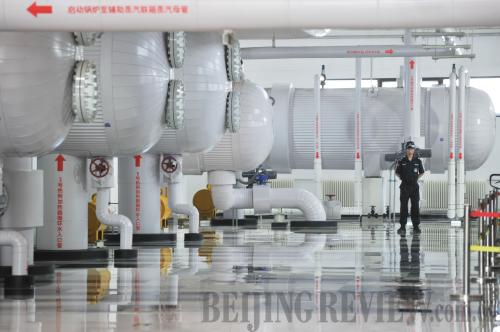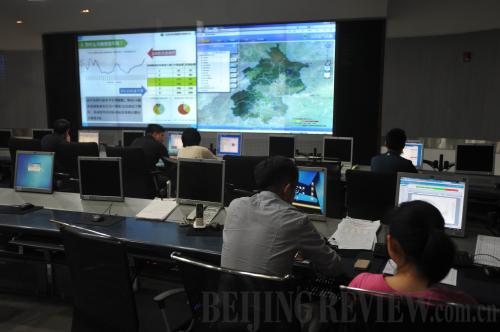|
 |
|
A security staff member guards the facilities of Beijing Jingxi Gas-fired Thermal Power Co. Ltd. on May 21 (WEI YAO) |
As the capital of the world's second largest economy, Beijing does not lack impressive infrastructure like skyscrapers and a constantly expanding subway. But now there are more changes that are not as visible but still have far-reaching impacts—chimneys that have stopped smoking, for instance.
This March marked a milestone with two coal-fired power plants in Beijing shut down. This move can slash the use of coal by 4.6 million tons per year. From the 1950s, four coal-fired plants had been used for electricity generation and centralized heating during the winter in Beijing. Today, only one of them is in operation still, and it will be closed by 2017, the deadline of Beijing's first five-year plan (2013-17) on air cleaning, to achieve 100-percent clean power generation. They are being replaced by four natural gas-fired thermal power centers.
The center in the northwest has been fully operational since October 2014. Compared to the coal-fired plant with the same capacity, the new gas-fired center is more efficient and occupies a smaller area, according to Zhao Jianbo, manager of the center.
Most importantly, it can reduce carbon dioxide, nitrogen oxide and sulfur dioxide emissions—the major air pollution contributors—by 2.45 million tons, 15.7 million tons and 7.42 million tons respectively every year.
In the first four months of 2015, Beijing reported fewer heavily polluted days, down by 42 percent from the same period of 2014. The density of PM2.5 (airborne particles measuring less than 2.5 microns in diameter and posing a health risk) decreased by 19 percent. Reduced coal burning, according to Fang Li, Deputy Director of Beijing Municipal Environmental Protection Bureau, is one of the key reasons for the improvement.
"There's a noticeable improvement [in air quality] compared to a year earlier," said Fang. "The past year witnessed our most aggressive measures to treat air pollution."
Beijing's air made global headlines in recent years. The city's average PM2.5 density in 2014 was more than twice the safe standard laid down by the WHO—35 microgram per cubic meter. The smog problem not only bothers the capital's more than 20 million residents but also poses obstacles for Beijing to play an increasingly important international role.
While bidding for the 2022 Winter Olympics, Beijing has promised to greatly improve its air quality so that when the games are held, the air quality in the city would meet the WHO standard.
 |
|
Researchers at Beijing Municipal Environmental Monitoring Center monitor the air quality in Beijing on May 21 (WEI YAO) |
In September 2013, the State Council, China's cabinet, issued the Action Plan for Air Pollution Prevention and Control. It set forth the goal of reducing the PM2.5 concentration in Beijing and its surrounding areas by 25 percent in 2017 to 60 micrograms per cubic meter. In the same month, the Beijing Municipality also unveiled its five-year Clean Air Action Plan (2013-17). It includes a raft of measures to reduce coal consumption, vehicle emissions and industrial pollution. An estimated $12 million will be spent to achieve the goal.
But experts observe that the plan sounds promising but is not enough on its own. Beijing is surrounded by mountains to the west and northeast, so the air quality depends on the wind's direction. The wind from the south and east—where the heavily industrialized provinces lie—brings pollution. According to Fang, one third of Beijing's air pollution came from outside in 2014.
"The progress we achieved last year should also be attributed to our neighbors' efforts," said Fang. Hebei, Beijing's most polluted border province, has issued dozens of policies and measures to fight pollution. For example, it promised to reduce its steel production capacity by 60 million tons from 2013 to 2017. The reduction is equivalent to 1.5 times Germany's annual production of crude steel. The cut in cement production and coal consumption will also be higher than the annual figures in Japan and Canada respectively. Four other nearby areas—Tianjin, Shandong, Shanxi, and Inner Mongolia—are also taking action under a collaboration mechanism set up by the Central Government.
Even then it is still too early to make a positive forecast, according to observers. Each year, Beijing sees a population increase of 500,000 and new construction of 200 million square meters. Its energy consumption goes up by 7 percent. In addition, the 5.6 million registered vehicles in the capital contribute to 31 percent of Beijing's pollution.
"For any country in the world, air pollution control has to be a gradual process," said Zhang Dawei, Director of Beijing Municipal Environmental Monitoring Center.
Beijing's efforts to combat air pollution started as early as 1998. In the past decade, the average PM2.5 intensity fluctuated between 80 micrograms and 120 micrograms per cubic meter. "Compared to the GDP growth, the situation has not worsened," Zhang said.
The monitoring center that Zhang works for has launched its website and app as well as a social media account to publish real-time air quality information.
"The fight will require everyone's efforts," said Fang, "Non-governmental organizations are welcome."
The government will ensure that enterprises and factories actively provide their pollutant emission information. Tightening emission standards will also be a focus, according to Li Sufang, an official at the Beijing Municipal Commission of Development and Reform.
Now Beijing has begun drafting the next plan, Clean Air Action Plan (2018-22). But before more thought is given to that, it's important to make sure that the first five-year plan has achieved noticeable results.
Beijing's Clean Air Action Plan (2013-17)
Energy Restriction
Cut coal consumption from 25.4 percent to under 10 percent
Replace four coal-fired power plants with natural gas-fired thermal power centers
Increase efforts to develop clean and renewable energy
Motor Vehicle Emission Reduction
Implement new stringent emission standards
Limit the number of vehicles in use to 6 million (5.6 million by the end of 2014)
Phase out or upgrade 1.5 million old vehicles
Introduce 200,000 new-energy and clean-energy vehicles
Industrial Emission Reduction
Shut down 1,200 heavily polluting enterprises
Implement more stringent and internationally advanced standards in heavily polluting industries
Dust Control
Build green spaces across the city and windbreak forests in surrounding areas
Monitor and control dust at construction sites
(Source: Beijing Municipal Government)
Copyedited by Sudeshna Sarkar
Comments to zanjifang@bjreview.com | 